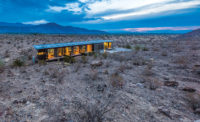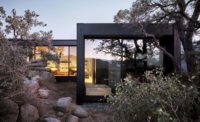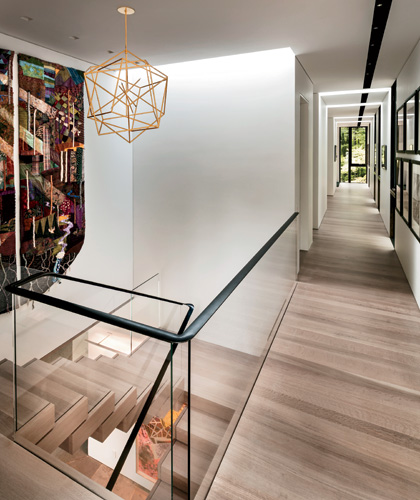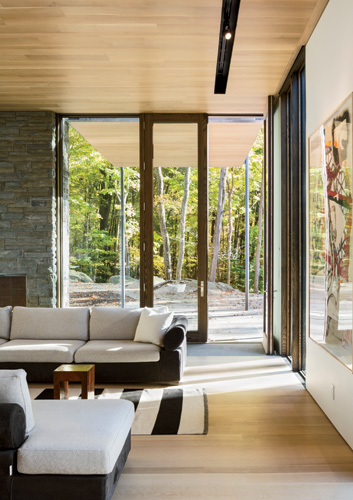Pound Ridge House by KieranTimberlake
Pound Ridge, New York




























Architects & Firms
In spite of high-profile projects like the U.S. embassy now under construction in London, Philadelphia-based architecture firm KieranTimberlake still sometimes accepts commissions for challenging single-family houses. “They are an opportunity to try out things that would be tougher on a larger project,” says design partner Stephen Kieran.
A key example is the Loblolly House, a weekend home for Kieran's family on Taylor Island in Maryland, where he explored how far the concept of off-site fabrication could be pushed. But with the firm's first completed house since Loblolly—a year-round residence for a mutual fund manager and his wife who works in film production—the focus was the effect of the changing seasons and different weather and atmospheric conditions on the architecture. “Time was a big design element for us,” says Kieran of the latest house built on a wooded, 33-acre site in Pound Ridge, New York—a bucolic town about 50 miles north of Midtown Manhattan.
Here the primary medium for architectural exploration was the building skin—a rainscreen composed of metal panels with a variety of finishes that reflect light and the surroundings in different ways. But before designing the house and its unusual envelope, the architects had to first identify the best place to build within their client's property, a process that was far from straightforward. Although the parcel was large, it was strewn with boulders and interlaced with wetlands. It was also steeply inclined, rising about 100 feet from the road to the ridge—the geologic feature that the name Pound Ridge refers to.
Within this difficult terrain, the architects were drawn to a pair of “rooms” defined by rock outcroppings near the site's highest point. The two small, level areas were positioned one below the other and separated by a narrow ravine. The spot, according to Kieran, provided the opportunity to create a house that “sits lightly on the ridge but is grounded.”
Without any blasting, KieranTimberlake was able build a dwelling of more than 5,000 square feet by inserting a rectangular volume into each plateau. They are clad primarily with the metal panels, but also in bluestone masonry, which has a coloring sympathetic to the boulders on the site. A two-story structure, comprising a double-height entry stair hall, the garage, and bedrooms, sits within the lower rock formation, while the upper one holds a one-story living and dining wing. The stair hall serves as the linchpin between the two elements, which are connected by an approximately 17-foot-long glass-enclosed bridge.
The main, 12-foot-tall living space features white oak ceilings and floors and full-height windows carefully positioned to provide dramatic views of the site's distinctive topography. Kieran explains that the strategy for placement of these apertures was much the same as the approach the owners would later use for hanging their art collection, which includes works by Giovanni Battista Piranesi, M.C. Escher, and Frank Stella. “We were very curatorial about it,” says Kieran. The architects were just as deliberate with the placement of skylights above the bedroom wing's hallway. The slot-like openings create a rhythm of direct and reflected sunlight that animates the long, narrow space.
These interior elements make for an elegant and very livable house. But the project's standout feature is its exterior skin. The different facade materials—brushed and polished stainless steel (both over an aluminum honeycomb core), lead-coated copper, and the glass of the windows—produce a varied surface that simultaneously reflects the surroundings and transforms the building envelope into an ever-changing abstract pattern. The cladding performs almost as camouflage, especially at the corners, where the use of the mirrorlike stainless-steel panels makes the building's edges practically disappear.
The overall arrangement of the cladding panels, which are of varying lengths, widths, and depths, seems random. However, the elevations were the product of intense study, according to Jason Smith, partner in charge of the project. The goal was to waste as little of the stainless and copper sheet material as possible and minimize the number of the highly polished panels (which were the most expensive), while providing richness and diversity.
All this attention to the skin produced more than just a stunning aesthetic effect. The cladding is part of a thermally robust and nearly airtight envelope system that includes structural insulated panels (SIPs). The house, which was designed with Passive House strategies in mind, also incorporates radiant heating, a geothermal system, and an energy-recovery ventilator. Kieran likes to compare the Pound Ridge project to Philip Johnson's Glass House, completed in 1949 in nearby New Canaan, Connecticut. Johnson's house is visually open to its environs, since it has no interior partitions and is entirely enclosed, on all four sides, in floor-to-ceiling single-pane glass. In contrast, the triple-glazed windows on the KieranTimberlake house make up only 13 percent of the building enclosure. Like the midcentury project, the Pound Ridge house is an example of a “dwelling within nature,” says Kieran, but one without “the same energy consequences.”
PeopleFormal name of building: Location: Completion Date: Gross square footage: Owner: Architect: Personnel in architect's firm who should receive special credit: Consultants: General contractor: Photographer: Cost: withheld Size: 5,250 square feet Completion date: September 2014 |
ProductsStructural system Exterior cladding Roofing Windows Doors Interior finishes Kitchen: Lighting controls & shades Other unique products that contribute to sustainability: |



















